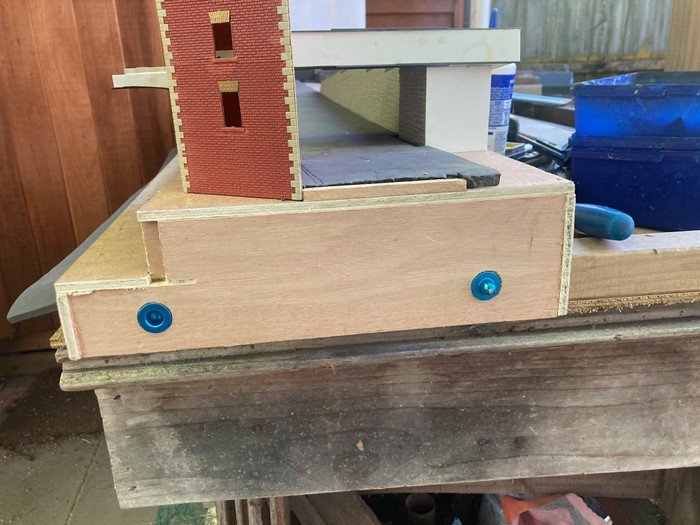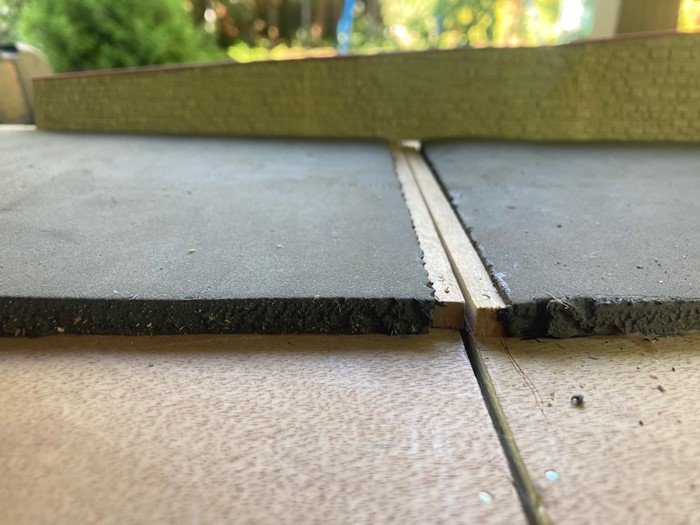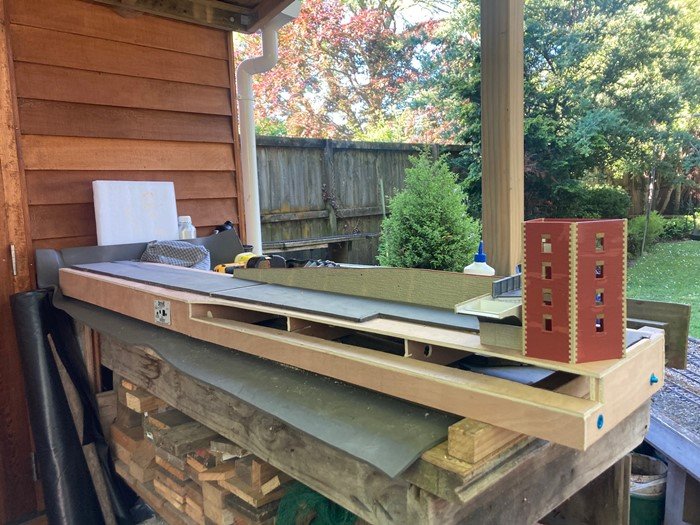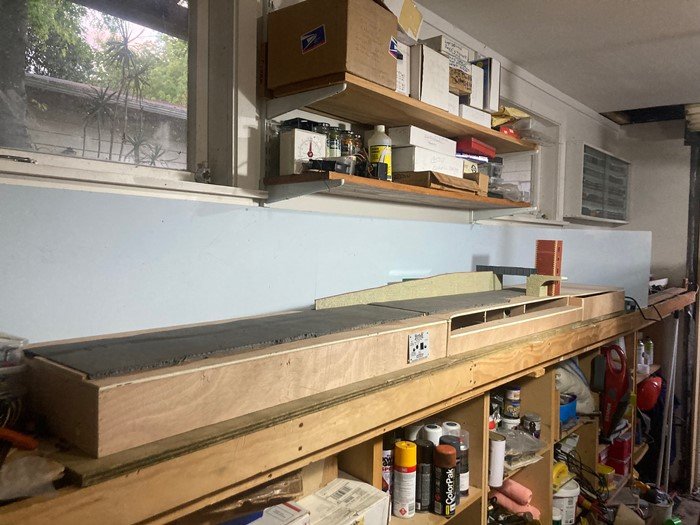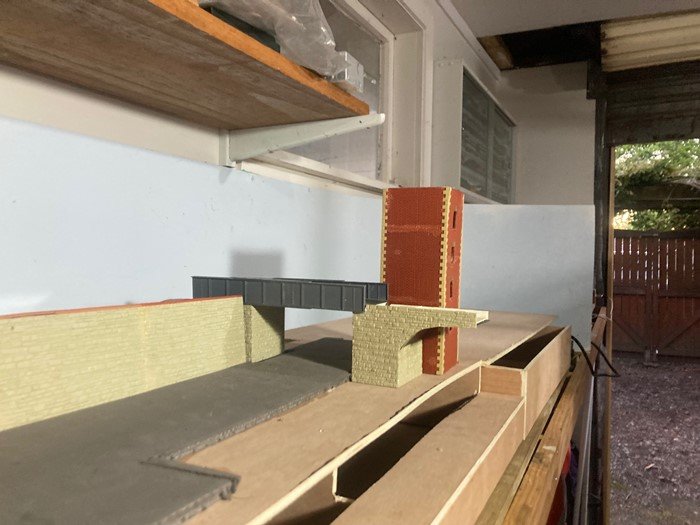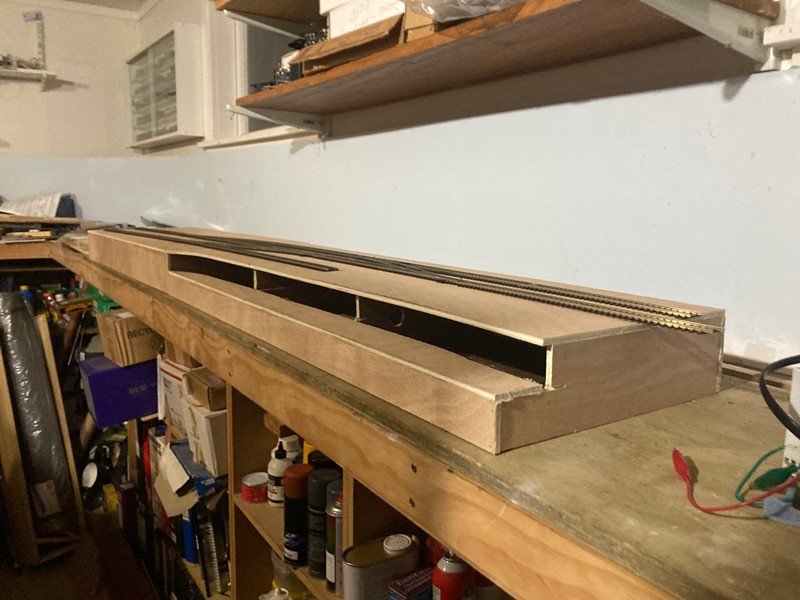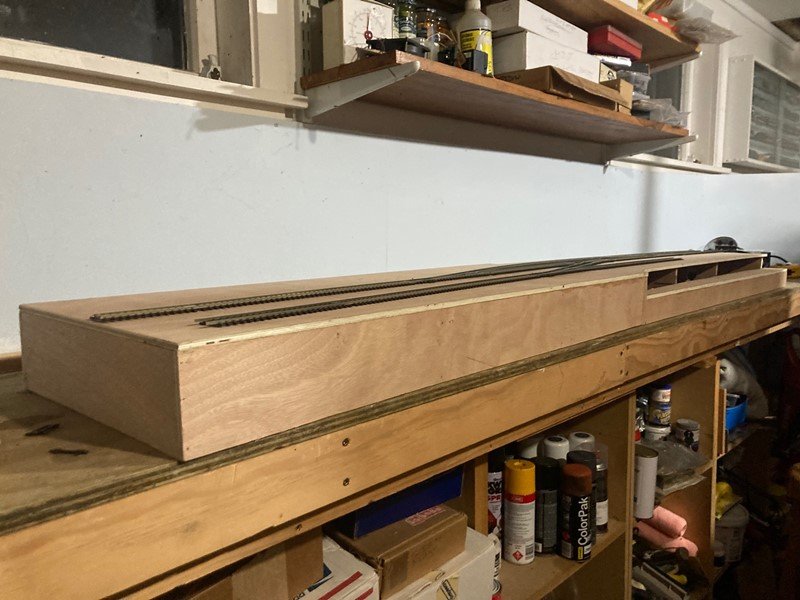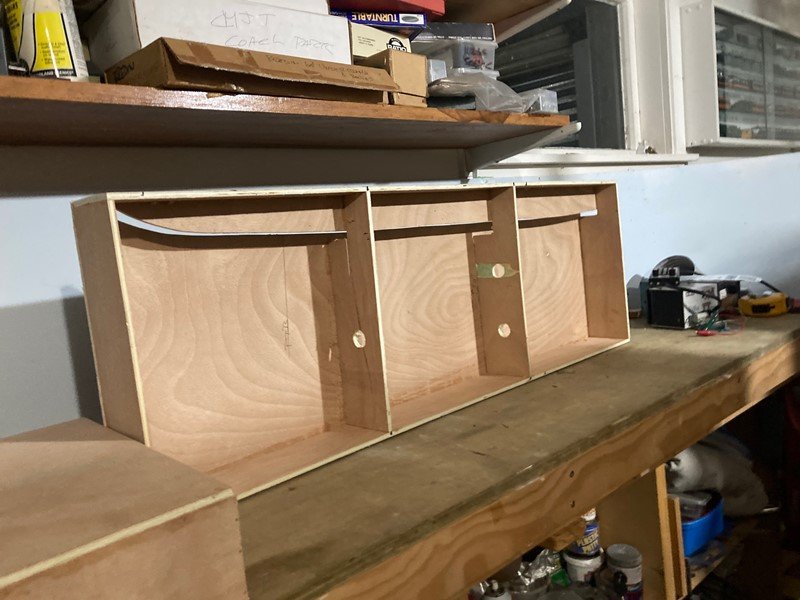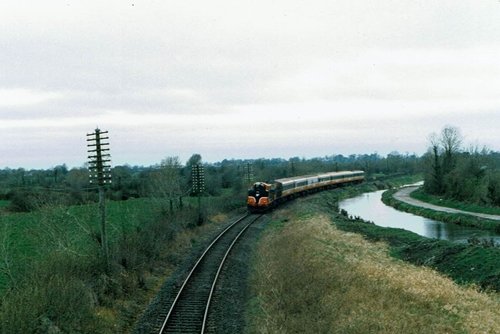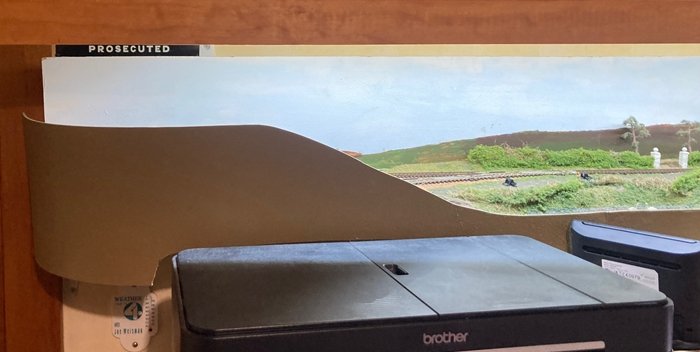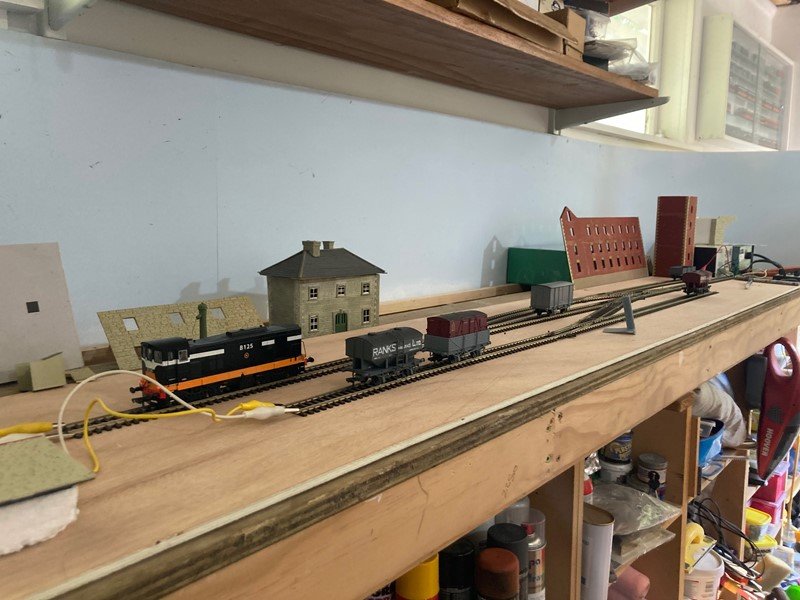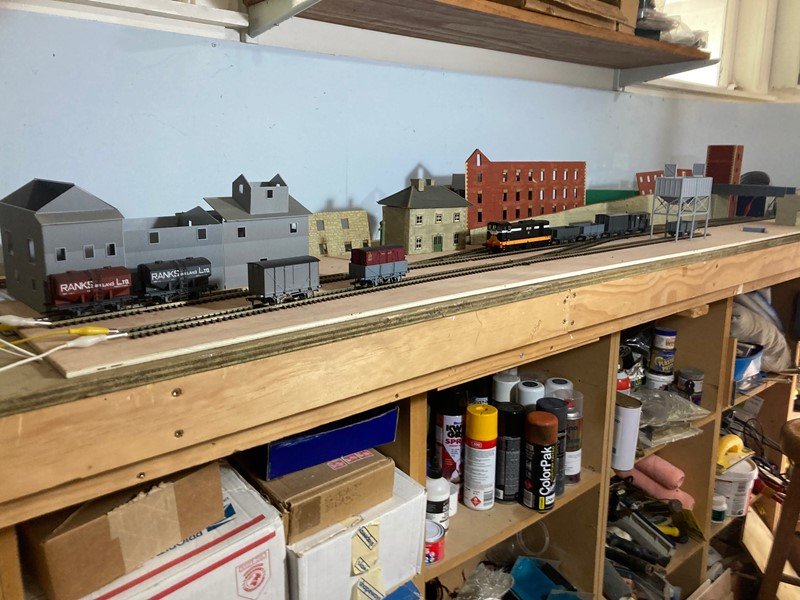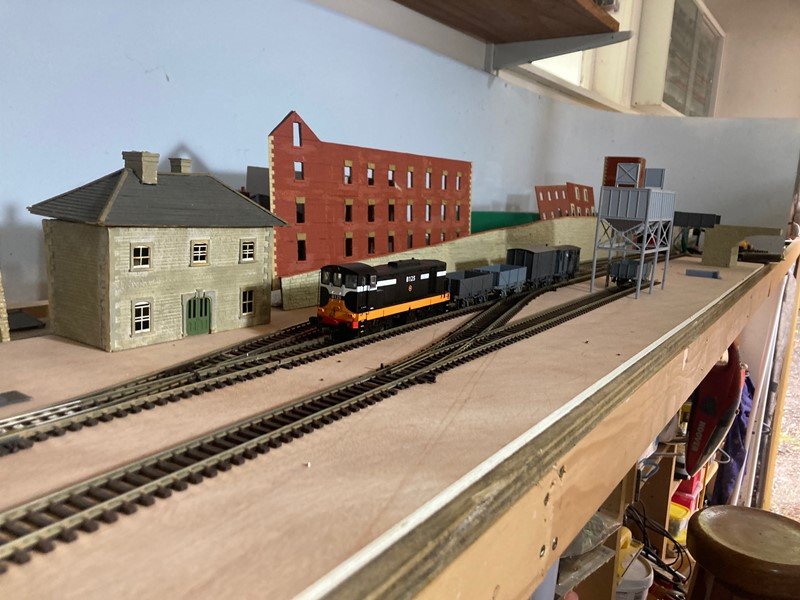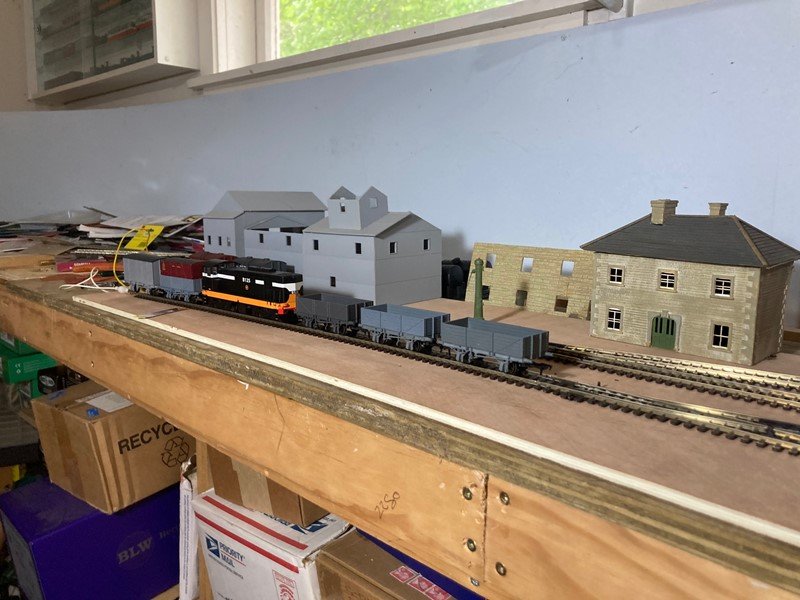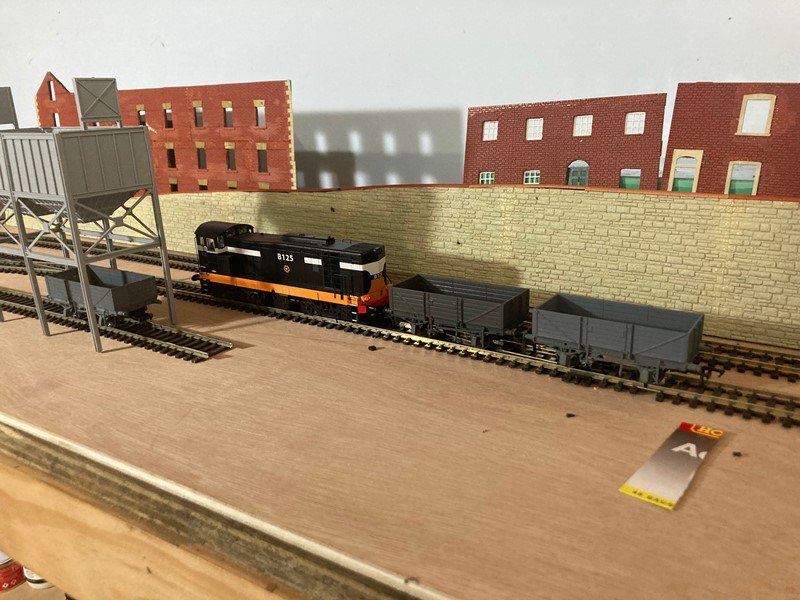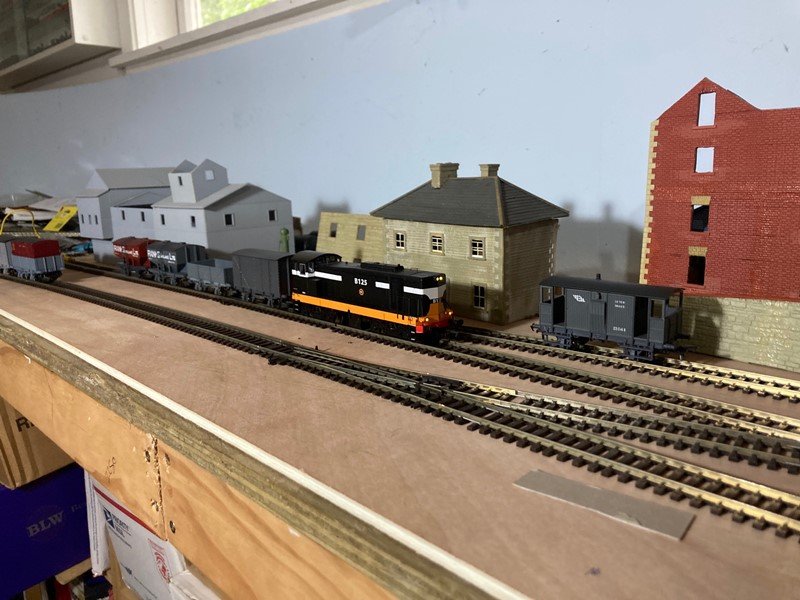-
Posts
4,879 -
Joined
-
Last visited
-
Days Won
119
Content Type
Profiles
Forums
Events
Gallery
Everything posted by Mayner
-
The DWWR opens almost look like early ore wagons with those massive solebars extending past the end framing almost like dumb buffers. Perhaps a hangover from the boom years of the Avoca Mines when copper ore was shipped by rail to Kingstown (Dunlaoire) Mineral Wharf. Hopefully some day you will get round to building a typical 19th Century DWWR 0-4-2 Goods Locomotive to haul them
-
It might be worth while trying Humbrol Decalfix rather than Microset and allow at least one week to allow any trapped moisture to evaporate before applying a clear sealer. Microset may be too severe Railtec Transfers recommend Decalfix which has worked well in finishing our rtr 3D printed brake vans. I use Gunze B523 "Mr Super Clear UV Flat" aerosol(misted on from a distance) for finishing wagons and locos as Testors Clear Cote is no longer available. Batch building wagons I allow a minimum of one weeks drying time after applying decals in a room with temperature and humidity control before finishing.
-
1100 and 1101 were basically the fore runners of the British Railways Derby and BRCW Type 2 Classes probably one of the most successful and useful Modernisation Scheme designs. https://www.derbysulzers.com/cie.html The main weakness in the two Irish mixed traffic prototypes was rough riding due to the plate frame carriage bogie design, the 1100-1101 engine and electrical were sound the Metropolitan Vickers electrical system was considered superior to the systems used in the BR Type 2. Its possible CIE went for plate frame bogies because cast steel bogies were un-available or prohibitively expensive in 1948 or someone in Inchacore simply compared notes with Eastleigh on Southern Railways experience with EMU and diesel electric locomotive bogies. Its a pity that CIEs budget did not stretch to bringing 1100-1101 into line with the B101 Class by increasing the BRCW order to 14 sets of parts, an additional pair of B Class locos with universal route availability would have been very useful until sufficient re-motored A Class were available to replace the B101 and pairs of GMs on the heaviest duties. The E Class are German locos with high speed Maybach Engines and Mekydro hydraulic transmissions, CIE gradually phased out the D301 Class Ireland sole example of the classic British diesel shunter by the late 1960s.
-
Completed the baseboards and installed track underlay this weekend. I fitted DCC Baseboard Alignment boards to the baseboards ends using a piece of ply with two pilot holes as drilling ji The underlay is dense foam ground sheet glued with PVA and weighted down until dry. I fitted strip basswood to the baseboard edge to assist with track alignment. Mock up on the outside work bench, Tower Building inspired by Grand Canal Street and overbridge will act as fiddle yard view blocker. Set up in the Workshop/Layout Room with Fiddle Yard baseboard fitted. The fiddle yard baseboard is basically an inverted box with an open top. I am planning to use a traverser using metal drawer slides., I will need to fit stripwood runners to the ply ends and an intermediate to support the slides, the traverser table will basically sit on top of the slides clear of the ply framing. The next jobs are to sort out the traverser top for the fiddle yard and drill out the pilot holes for the point motors. I seem to have disappeared most of the track/pointwork for this end of the layout since Saturday morning, I suspect it has fallen into the narrow gap behind the under-baseboard storage units which will require a major clear out
- 56 replies
-
- 12
-

-
Dan Renehan a CIE driver wrote a series on papers on CIE diesels including the E401 & 421 Classes in the IRRS journal during the 1980s. The majority of the operational E401s lost their exhaust cowl and silencer as a result of an exhaust fire when one of the class was working as Inchacore Works Pilot (Sambo). The class were gradually withdrawn in the late 70s/early 80s though apparently the the last operational loco possibly E401 retained her silencer and cowl. The E401s were basically worn out after years on heavy duties working Heuston-North Wall transfer freights. Some E421 originally based at Connolly were transferred to Heuston to undertake coaching pilot duties. According Locos and Stock of CIE & NIR (Doyle & Hirsch) E401,411,415,417 and 419 were withdrawn by 1979
-
I did not realise that the GSR operated a Cork-Bandon local passenger service, I was under the impression that Bandon was served by Cork-Skibbereen & Clonakilty trains in CBSCR and GSR days. The Muskery is an odd one the GSR received a 5% Baronial Dividend on the CMLR share capital for 10 years following the Amalgamation, the GSR operated a skeleton service of one or two trains daily in its final years until the dividend payments ceased in 1934. Presumably the payments would have ceased if the GSR closed the line earlier. According to Shepherd the GSR wanted to close the Timoleague and Courtmacsharry line in 1925 but continued to operate the line possibly in order to continue receiving a dividend under the Baronial Guarantee scheme but was worth while keeping open for goods and excursion traffic.
-
Branch lines feeder branch lines close to large cities and towns such as Dublin, Cork and Drogheda tended to loose their passenger service or completely once the railways established their bus and road delivery services. Macroom lost its passenger services in the early 30s and the Passage and Muskerry lines were closed completely during the same era, I suspect the Muskerry hung on until the Government Baronial Guarantee payments ceased in 1934 otherwise the GSR would have closed the line earlier. The GSR & CIE seem to have operated a sparce passenger service on the Tullow Branch, the Meath line and Cavan Branches, it was cheaper to serve Naas, Navan and Cavan by bus direct from Dublin with the bonus of GSR/CIE operating a direct Dublin-Navan-Kells-Cavan service something that was impossible to do by rail. The Ardee goods service appears to have survived because it could be worked as a Drogheda shunting or pilot duty in a similar manner to the Tralee Pilot working the Castleisland, Listowel and Fenit shunts rather than an allocated locomotive. The principal applied on a larger scale before the 1963 Closures with the Liffey Junction Pilot (G 611 Class) working the weekly Edenderry Goods and trip workings to Kilmessan and Drumree when Clonsilla-Navan closed to through freight workings, the Clara Pilot (G601) worked the Banagher Goods in addition to shunting the goods yard, Ranks/RF Hall and LF Goodbody Jute factory sidings, during the 1930s the Mallow pilot worked the Kanturk Newmarket goods allowing a Sentinel Railcar replace a locomotive and coaches on the branch passenger service.
-
Its interesting how overseas railways turned out successful 4-6-4T locomotives while British companies struggled to produce a successful 4-6-4T tank with the notable exception of the Brighton Baltics. The main problems with the British locos appears to have been poor front end and ashpan design. On the 3'6" gauge NZR successfully used 4-6-4T for branch line, mixed traffic and suburban design. Interestingly the first NZR Baltics the WW Class of was a 1913 development of a 1904 2-6-4T design, the final NZR 4-6-4T design the Wab/Ws class was a 1919 development of a 4-6-2 Mixed Traffic design https://en.wikipedia.org/wiki/NZR_WAB_class All NZR 4-6-4T Classes were modern designs with long travel valves outside valvegear and free steaming boilers.
-
I worked for regulatory bodies in both Ireland and New Zealand, sometimes they end up in the pockets of the industries they are intended to regulate. Large organisations such as Government Departments, regulatory bodies, the banks and An Post tend to behave as a living organism and tend to treat any challenge or criticism in a similar manner to our antibodies fighting an infection and are prepared to fight most challenges through the courts until the plaintiff either dies or runs out of money rather than admit to a mistake or error.
-
I had an interesting response to a complaint I lodged with the Office of the Communications Regulator that An Post was misleading customers and postal authorities by advising that items were rejected by the Revenue Commissioners and items still in An Post's possession had been returned to sender. The Irish Communications Regulator basically replied that they did not want to know, as I had not lodged an official complaint with an Post and were not interested in anything to do with customs. An Post advised me early in September than an item was rejected by the Revenue and had been returned to sender, but managed to scan the item in the Dublin Mail Centre four weeks after it was returned to sender, eight weeks later I can only assume that An Post have lost the item as it has not re-materialised in the NZ Post tracking system or been physically returned. On the positive side I am trialing DHL Express for a high value DTP shipment to the UK, our DHLs account managers advice was not to complete or worry about the customs declaration as they would complete it correctly as customs clearance is included in the shipping fee.
-
It would be worth while having a look for Vol 1 RM Arnold's Golden Years of the GNR through the library system if you do not have a copy. Mac Arnold focused on train working and the people that worked the railway more folklore than a conventional railway history.
-
Brookhall Mill was one of the inspirations for East Dock. Assembled the baseboards this afternoon, ensured consistency by ripped the framing using a circular table saw and cut the framing to length with a cross compound mitre saw. I marked the position of the point tie bars before positioning the intermediate cross members. The fiddle yard will be a traverser on a separate 250X300mm baseboard. The layout will have a painted hardboard fascia and backscene, backscene will have radiused corners similar to that in the background.
-
It looks like Tim Cramer did a lot of the original research before Cork area locos and stock were scrapped in the 50/60s. Roger kindly provided a Tim Cramer sketch of a MGWR tender bunker detail possibly from a J18 that was overhauled and painted black in Cork during the late 1950s. Tim popularised Irish modelling during the 1970s published drawings and articles on No 90 and the "Bandon Tanks" in the Model Railway Constructor late 60s early 70s and the "Irish Miscellany" series of articles which included the 800 Class, Kerry & Achill Bogie 4-4-0s, MGWR 6w Coaches, MGWR small tanks, Argadeen, GSWR Brake Van, GSR Open, B141 and Waterfall Station in Model Railway magazine in the mid late 70s, together with articles on his own work in 4 and 7 mm scales.
-
Brings back happy memories reminds me of days trainspotting on the Midland in the 80s and 90s. Usually Craven train consists until MK2D cascaded onto the line in the late 80s
-
It seems a co-incidence that we both end up building dock harbour layouts to fit a 7'6" space though in different scales. I went for OO and Peco small radius points as I would have struggled to fit the tracklayout in the same space in 21mm gauge because of the longer point leads! Would you consider moving the crossover towards the tunnel to provide a longer run round loop, though it leaves you with the downside of loosing part of the quay siding, I guess you could build a GSWR Railmotor for passenger services and use St Molga or possibly a model of GSWR 100 for goods. I better be careful I seem to be talking myself into a 7mm Timoleague & Courtmacsharry layout before I even get to grips with 4mm in OO or 21
-
There were 3 Black Hawthorn 0-4-2Ts built for the Ballymena-Parkmore-Retreat line which became NCC 101-103, 102 & 103 had their saddle tank extended to the front of the smokebox as in the photo. Two were loaned to the Cavan & Leitrim to work coal trains in 1920 but later returned to the NCC and scrapped so I just have to have one!
-
It sound like the new book may partially duplicate "The Dingle Train" David Rowlands, Walther McGrath and Tom Francis Plateway Press 1995 which is well worth looking out for! https://www.amazon.com/Dingle-Train-David-Rowlands/dp/1871980275 The book is ideal for the modeler including a short history of the line, social history, a large section of photos drawings and photos of locos, coaches and freight stock and a detailed history of each locomotive. The Tralee and Dingle Railway David Rowland Bradford Barton 1977 is probably the best source of photos of the line locos and stock copies available of Amazon from $17 https://www.amazon.com/Tralee-Dingle-Railway-David-Rowlands/dp/0851532675 I used 'The Dingle Train" as a reference for building my models of 3T & 6T
-
Well spotted a relic with MGWR design features built over 30 years ago using Wills scenic materials. It was the station building on a minimum space MGWR branchline terminus inspired by Richard Chown's Castlerackrent. An early attempt at 21mm gauge a turntable release and a double slip were beyond my scratchbuilding ability. The building will act as a Customs House/Dock Office as East Dock is goods only though definitely MGWR!
-
A concealed fiddle yard works well where a layout is operated from behind such as at exhibitions, but can be a nuisance if a layout is operated from the front. The fiddle yard on my Irish narrow gauge layout is partially concealed and all the shunting/fiddling has to take place on the scenic part of the layout.
-
I was always fascinated by port and dock railways and needed a OO gauge test track and backdrop for my models, so I looked at the John Allen's Timesaver switching puzzle for a small self contained layout. The Timesaver was basically a model railway board game where the operator shunts/switches 5 freight cars between set starting and final positions in the shortest time possible. Originally intended as a brainteaser for operators on John Allen's famous Gorre & Daphetid Railroad, the original Timesaver layout was on a plain baseboard with no scenery or stopbolcks to stop stock running off the ends of spur tracks. I first worked out the minimum space require by setting up a Timesaver track layout with the original design constraints based on Irish 4w wagons & a B121 locomotive. Timesaver mock up with B125 and 5 wagons. Min length 1600mm. The main Timesaver constraints are that the spur tracks are each capable of holding 3 vehicles (loco or wagons), the run round loop and release tracks a maximum of 2 vehicles. Track is Peco Code 100 with small radius Insulfrog points which I had in stock. In practice the length of the release tracks limit the majority of moves to a loco and 1 wagon, though its possible to shunt two wagons when pushing and pulling. I extended the scenic section to 1850mm as I had a suitable piece of ply with a 500mm fiddle yard section to fit a 2350 shelf in the home office which would allow more realistic operation 1850mm extended Timesaver Mock Up. The extra 250mm allowed me to extend the run-round loop to hold 5 wagons and extend the release and spur tracks at one end to hold an additional wagon. The increased length & fiddle yard allows more purposeful shunting that possible with the original Timesaver concept. A train can be made up off scene and arriving/department traffic modelled rather than just shuffling wagons back and forth. The corrugated buildings are a mock up for 1930s era grain silos/feedmill, the large red brick buildings are based on the Canal era maltings on the North West side of Grand Canal Dock. B132 arrives with two empty opens, a covered wagon and a brake. B132 has propelled her train out of the year before uncoupling the opens from the remainder of the train before running forward to pick up the 'full" wagon from under the hopper and position to two empties. B125 has run round her train and positions the brake on the loop so the guard can complete his paperwork in comfort while the (human) shunters make up the outgoing train. B125 has picked up the outgoing Ranks Wagons and Open to add to the outgoing train before shunting the incoming Covered Wagon into position at the mill. Ready to depart B132 has collected the outgoing traffic, the crew have retired to the office building for lunch before departure. Apart from the track most of the layout will be built from material in stock, the baseboard will be all ply construction with track on dense foam underlay. Point motors are Peco likely to be controlled using Lenz stationary decoders last used on an N gauge layout, control Digitrax Empire Builder system with Duplex Radio remote control. Buildings and structures are mainly salvaged from earlier projects mainly built using Will Scenic Sheets. Scenically the layout is a section of rail served quay or basin with backround buildings and structures. I will probably do a couple of mockups of the Feedmill Grian silo, possibly 1930s concrete construction or corrugated iron, the hopper arrangement for loading wagons is similar to that used at Waterford North Wharf The next job is to cut the profile of the quayside out of the baseboard top and assemble the baseboard, the baseboard framing will be formed from 80mm rips of ply with the quayside area reduced to 50mm to give a shallow quayside basin effect.
- 56 replies
-
- 24
-

-

-

-
I have updated the web site and we are currently accepting orders for the Ranks Grain and the CIE 1946 Covered Wagon https://jmdesignmodelrailways.com/blogs/news/october-2021-update
-
Australia and New Zealand are not far behind the States in per capita energy use, the coal, gas and mining lobby has a similar influence on Australian politics while NZ tends to oscillate between Neo-Liberal and and more Interventionist (slightly left of center) economic policy. Like Ireland and the UK the elephant in the room in New Zealand is poor health and high home heating costs as a result of poorly insulated and ventilated homes. The cost of owning a car or truck in Ireland tended to be higher than the UK as a result of high rates of taxation, most appears to go into the General Fund (health, welfare, education, public transport rather than being ring fenced for roading and traffic policing. Ireland faces similar challenges though on a smaller scale to the United States, Australia and New Zealand with high per capita energy use for transportation and housing compared to countries with higher population densities in the Far East, the UK, Germany and the Benelux Countries where its economic to provide efficient public transportation and high density housing. Ireland is likely to be faced with the twin challenges of establishing sufficient 'green" electricity generating capacity to power a changeover to EVs for personal transportation and the IT industry (incl Data Centers) essential for economic development while simultaneously getting the public to accept paying similar rates of excise duty for re-charging an EV as petrol or diesel. Although NZ electricity generation is mainly renewable (hydro and wind) we are currently importing coal from Indonesia as our natural gas fields are unable to meet peak demand. One of the more interesting changes in the United States during the past 15-20 years is the increased shift to Bio-Diesel and Ethanol refined from corn grown in the Mid Western grain belt. Some of the Bio-fuel companies have ties to agribusiness and food processing with strong links to agriculture rather than established oil and gas companies. It will be interesting if businesses such as Glanbia and Kerry diversify into ethanol and bio diesel as an alternative to dairy and meat processing as livestock numbers are reduced in an attempt to control greenhouse emissions. Personally I am unlikely to go for an EV, I recently replaced our 25 year old SUV with a slightly more modern low emission model after our last vehicle was written off in a collision. The current vehicle hopefully should last another 10-15 years till I pop my cloggs or am no longer fit to drive.
-

Self propelled cranes and small coasters
Mayner replied to David Holman's question in Questions & Answers
Classic Iain Rice with trademark single slip on the crossover on the run round loop -
Irish Covered (Convertible) and Cattle Wagons appear to have been built to a length of 13'6" over headstocks up to an Oct 1892 IRCH Order which fixed minimum inside dimension of 14' X 7'3" for wagons to carry cattle. The MGWR increased the length of its Convertible Wagons to 14'2" in 1893 (1" body planking). Open Cattle wagons (both crib & roofless) continued to operate on both the Broad and Narrow Gauge until at least the late 1950s. Open (crib) Cattle wagons were used on both the Tralee and Dingle and Cavan & Leitrim until closure, while roofless K & KN (14' & 17'6") cattle wagons appear in several photos of 1950s steam hauled fair Specials. Presumably roof covering and planking was removed but wagon continued in service when roof boarding was decayed rotten but wagon otherwise servicable. The order presumably would have applied to new construction and existing wagons as they came due for renewal/re-building, its possible that some 13'6" wagons (shortie-shortie?) were still in service into the 1920s or possibly later. The MGWR had a policy of replacing/renewing all locos and rolling stock on a 25 year cycle, which would have left approx 200 Convertible and Open Cattle wagons introduced in 189-2 due for renewal between 1916-17, with replacement likely to be delayed into the mid 1920s as a result of War time disruption.
-
Station looks familiar and the tracklayout is prototypical! It will be interesting to see if Tony models a working Horse Tram.
.png.c363cdf5c3fb7955cd92a55eb6dbbae0.png)

